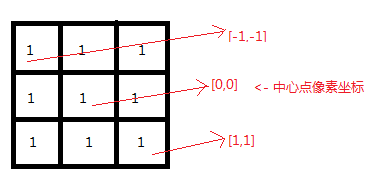图像处理之二值腐蚀
来源:互联网 发布:个人开发者 知乎 编辑:程序博客网 时间:2024/05/30 22:58
图像处理之二值腐蚀
概述:
腐蚀是图像形态学的两个基本操作之一,另外一个是膨胀(Dilate)。二值图像上的腐蚀是腐蚀最典
型的运用,但是腐蚀操作同样可以运用于灰度图像。二值图像腐蚀操作最基本的效果是腐蚀图像
中前景色区域的边缘。使得前景图像区域变小,前景图像内部的背景区域被放大。
基本原理:
腐蚀操作要求有待处理的2D图像F(x,y)以及操作数矩阵(类似卷积操作中的Kernel矩阵),常见的
为3X3的操作数矩阵。二值图像腐蚀操作的数学定义如下:
1. 假设X是二值图像中所有像素欧几里德坐标的集合,K为3X3的操作数矩阵
2. Kx表示操作数处理X的结果,x表示起始像素点
3. 腐蚀操作K对X的所有像素点操作,Kx是X所有像素点的子集。
一个二值图像腐蚀的例子如下,操作数矩阵为3X3,起始点为中心像素点,前景像素表示为1,背
景像素表示为0.图示如下:

当操作数在像素矩阵上移动时,任何一个在操作数之下的输入像素为背景像素时,则设置中心像素
为背景像素0,否则中心像素[0,0]下的输入像素值不变。
package com.gloomyfish.morphology;import java.awt.Color;import java.awt.image.BufferedImage;public class ErosionFilter extends BinaryFilter {private Color backgroundColor;public ErosionFilter() {backgroundColor = Color.WHITE;}public Color getBackColor() {return backgroundColor;}public void setBackColor(Color forgeColor) {this.backgroundColor = forgeColor;}@Overridepublic BufferedImage filter(BufferedImage src, BufferedImage dest) {int width = src.getWidth(); int height = src.getHeight(); if ( dest == null ) dest = createCompatibleDestImage( src, null ); int[] inPixels = new int[width*height]; int[] outPixels = new int[width*height]; src = super.filter(src, null); // we need to create new one getRGB( src, 0, 0, width, height, inPixels ); int index = 0, index1 = 0, newRow = 0, newCol = 0; int ta1 = 0, tr1 = 0, tg1 = 0, tb1 = 0; for(int row=0; row<height; row++) { int ta = 0, tr = 0, tg = 0, tb = 0; for(int col=0; col<width; col++) { index = row * width + col; ta = (inPixels[index] >> 24) & 0xff; tr = (inPixels[index] >> 16) & 0xff; tg = (inPixels[index] >> 8) & 0xff; tb = inPixels[index] & 0xff; boolean erosion = false; for(int offsetY=-1; offsetY<=1; offsetY++) { for(int offsetX=-1; offsetX<=1; offsetX++) { if(offsetY==0 && offsetX==0) { continue; } newRow = row + offsetY; newCol = col + offsetX; if(newRow <0 || newRow >=height) { newRow = 0; } if(newCol < 0 || newCol >=width) { newCol = 0; } index1 = newRow * width + newCol; ta1 = (inPixels[index1] >> 24) & 0xff; tr1 = (inPixels[index1] >> 16) & 0xff; tg1= (inPixels[index1] >> 8) & 0xff; tb1 = inPixels[index1] & 0xff; if(tr1 == backgroundColor.getRed() && tg1 == tb1) { erosion = true; break; } } if(erosion){ break; } } if(erosion) { tr = tg = tb = backgroundColor.getRed(); } else { tr = tg = tb = 255 - backgroundColor.getRed(); } outPixels[index] = (ta << 24) | (tr << 16) | (tg << 8) | tb; } } setRGB( dest, 0, 0, width, height, outPixels ); return dest;}}阅读全文
0 0
- 图像处理之二值腐蚀
- 图像处理之二值腐蚀
- 图像处理------ 二值腐蚀
- 二值图像--形态学处理2 腐蚀和膨胀
- Win8Metro(C#)数字图像处理--2.21二值图像腐蚀
- 二值图像的腐蚀
- 二值图像的腐蚀
- 图像处理之膨胀腐蚀操作
- 图像处理之膨胀腐蚀操作
- 形态学图像处理之腐蚀与膨胀
- 二值图像的腐蚀和膨胀
- 二值图像的腐蚀和膨胀
- 二值图像的腐蚀和膨胀
- 二值图像腐蚀(vc实现)
- 二值图像的腐蚀和膨胀
- 二值图像的腐蚀和膨胀
- 二值图像的腐蚀和膨胀
- 二值图像的腐蚀和膨胀
- extjs问题2
- 常见的数据结构
- 《剑指offer》最小的k个数
- 初识C++11 中的线程操作
- QA数据中心环境部署
- 图像处理之二值腐蚀
- 生命周期
- 三.数据结构与基本绘图(2.常用图形数据结构)
- String的方法-第八天
- 幸运数
- 收集整理的工具代码片段链接
- 运行TFFRCNN算法
- 欢迎使用CSDN-markdown编辑器
- 点对点和端对端通信


